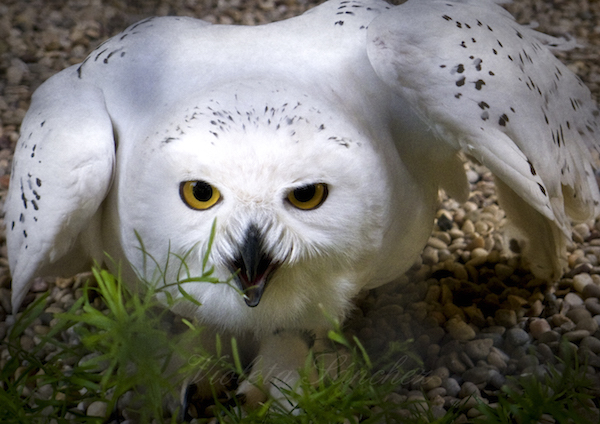Snowy Owl, Nyctea scandiaca
The Owls are an order of birds of prey. Most are solitary, and nocturnal. They are classified in the order Strigiformes, in which there are approximately 167 species. The Little Owls, Strix and Scops Owls belong to the eagle owls. The barn owls belong to a different family, with approximately 14 species. There are anatomic differences between both families, but many common characteristics apply to both.
 Main characteristics
Main characteristics
The major part of the eagle owls have their eyes surrounded by a facial disk of rigid feathers which appear eyebrows. Because owls are generally active at night, they have a highly developed auditory system. Many eagle owls have asymmetric craniums, with ear openings on different levels. This makes it easier for them to localize their prey due to their noise. The eyes of the Eagle Owls (which are smaller than the eyes of Barn Owls) are large and forward facing. They are held in place by bony structures for which an owl cannot “roll” or move its eyes. The owl more than makes up for this by being able to turn its head around, and almost upside-down. It is able to achieve this by having a long and very flexible neck, which allows the owl to turn its head through a range of 270 degrees measured from a forward facing position.
Eagle Owls and Barn Owls are found on all continents except Antarctica, and in a great variety of habitats, from thick forests to open prairies. Barn Owls have a wider range of distribution than any other bird species of the world. The breeding habits of owls vary according to the species. Some breed in tree holes, others between rocks. Some build big nests in trees and others, such as the Burrowing Owl, nest on the ground.
All owls lay white eggs. They feed exclusively on living animals. The size of their prey is proportional to the size of each species. Potential prey species are insects, or small mammals of the size of hares. Some owls feed only on fish. The indigestible parts (fur, bones, teeth & feathers that are still in the gizzard) are compressed into a pellet the same shape as the gizzard; the analysis of the pellet allows to identify the prey species.
Some genera of the Strigidae family have many species, in one case more than 50. Many members of this genus are well known, such as the Long-Eared Owl, which is native to North America, or the European Scops Owl, a migratory species native to southern Europe, from the Iberian Peninsula to the Lake Baikal. However, many of the tropical species are only known through a few specimens displayed in museums, whose habits have never been properly investigated.
One of the biggest owls in the world is generally accepted to be the Eurasian Eagle Owl. They have ear tufts, which really have nothing to do with ears. Only the South American Great Horn Owl is native to the American Continent, but in Europe, Africa and Asia, more than 17 species of Eagle Owls exist. The Eurasian Eagle Owl has the widest range of distribution of all Eagle Owls. It is found from Scandinavia to Spain or Japan. Its average body length is 71cm. The Snowy Owl, native to the northern part of Eurasia, differs from other owls for being a day hunter. Its preferred prey species is the lemming. The adult male is virtually pure white, but females and young birds have some dark scalloping. Also the Northern Hawk Owl hunts during the day.
The smallest owl in the world is the Elf Owl, native to the southwest of the USA and Mexico. It is 13cm tall and nests in holes excavated by woodpeckers in big cactuses. Other of the smallest species are the Eurasian Pygmy Owl, 16 cm tall, and the Little Owl, with 21cm. The latter is quite frequent in central and southern Europe and also on the Iberian Peninsula.
The Long-eared Owl, 35cm tall, is another of the resident species of the Iberian Peninsula. It has “long ears” and usually lives in coniferous forests. The Tawny Owl is the most common Strix species in Europe, including Spain. This owl is absolutely nocturnal. The Short-eared Owl and the Tengmalm’s Owl are two other species of the Iberian Peninsula, which belong to the family of the Eagle Owls.
Cientific classification: The Eagle Owls belong to the order Strigiformes. The typical Eagle Owls belong to the Strigidae group, while the Barn Owls belong to the Tytonidae family. The scientific name of the Barn Owl is Tyto alba, while the Burrowing Owl is named Speotyto cunicularia. The genus with most species is Otus. The scientific name of the Eastern Screech Owl is Otus asio, and the Eurasian Scops-Owl’s Otus scops. The Eagle Owls make up the genus Bubo. The scientific name of the South American Great Horned Owl is Bubo virginianus, the Eurasian Eagle Owl is named Bubo bubo. The scientific name of the Snowy Owl is Nyctea scandiaca and the Northern Hawk Owl’s Surnia ulula. The Elf Owl’s scientific name is Micrathene whitneyi, while the Eurasian Pygmy Owl is named Glaucidium passerinum. The Little Owl is known as Athene noctua, the Long-eared Owl Asio otus, the Tawny Owl Strix aluco, the Short-eared Owl Asio flammeus and Tengmalm’s owl Aegolius funereus.
Snowy Owl, Nyctea scandiaca
Facts:
How are they? Their average body size ranges between 53 and 65cm in length and their wingspan ranges between 120 and 151cm. The adult male is virtually pure white, but females and young birds have some dark scalloping. Their colour helps them to camouflage in their natural habitat.
Where do they live? During summer, they live in the tundra, close to rocky hills. In winter, they migrate to areas with farmland and low vegetation.
How is the species geographically distributed? The species is native of the Northern hemisphere. It breeds in the tundra and winters in the central part of the Northern hemisphere.
What do they feed on? On medium-large birds, lemmings and fish.


